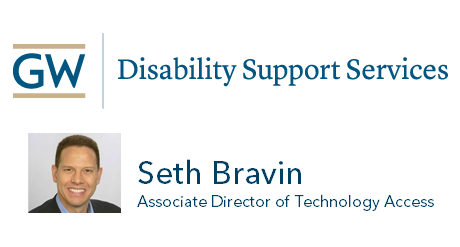From IBM to the United States Business Leadership Network Conference, Seth Bravin brings over a decade of accessibility expertise to the George Washington University.
Bravin joined Disability Support Services just last year as the new associate director of technology access. In this role, he works in close collaboration with stakeholders across the university. Bravin considers technology access, or digital access, as a critical component of the learning experience for students with disabilities, as well as for faculty, staff and visitors who have disabilities.
Bravin says he was brought in to address some of the challenges in the new, technology-based learning environment of the 21st Century. As web apps, mobile phones and other technologies become a part of everyday life, professionals must assess the “growing pains” associated with that transition in the academic environment. “Online education, for example, is really a challenge because some students don’t self-identify their disabilities, so we want to make sure that the university is fully accessible for everybody,” he said.
As a result, Bravin and DSS, established at the university in 1978 to foster a climate of universal academic excellence and to promote disability culture, consider online education and web accessibility among their top priorities in the new year and imagine it will stay a top priority for the foreseeable future. “If you think about a new building like the Science and Engineering Hall, they built the elevators and ramps to ensure the building is fully accessible as a permanent function of the space,” Bravin said. “With digital access, however, it’s an ongoing effort just like gardening. You have to continually monitor the process and address new issues.”
Bravin, a father of three, spends the average day meeting with administrators to discuss accessibility initiatives, giving presentations on accessibility best practices and making calls to vendors who provide accessibility solutions such as captioning. At home, he enjoys spending time with his wife and kids, who he says are very involved with sports.
Here at GW, Bravin says he sees a strong commitment from different parts of the university to advance university-wide accessibility best practices and a willingness to evolve. As a relatively new member of the campus community, he says he looks forward to continuing the university’s long history of serving students with disabilities and developing close ties with other parts of the university.
“I recognize the importance of collaborating with university stakeholders to launch accessibility initiatives and to identify opportunities to incorporate universal design principles to maintain the university’s commitment to accessibility,” Bravin said.
Moreover, given the university’s renowned reputation, Bravin feels there is a real opportunity to contribute to the field of best practices in accessibility.
“The university has a global presence,” he said. “In April, we will be working with the Department of State to host a visiting delegation from China that will be coming here to learn more about GW’s commitment to people with disabilities and its disability services. The university has a unique opportunity to develop partnerships and collaborate with organizations outside of GW.”
And engaging the entire campus is important to Bravin, as accessibility is not only for students registered with DSS, but also for all of GW.
“Accessibility benefits everyone, not just people with disabilities. Captioning is a good example. You now see captioning in many places including airports and restaurants,” he said. “Our work will enhance the university’s learning environment, and we have an opportunity to help make the world a better place for people with disabilities.”


